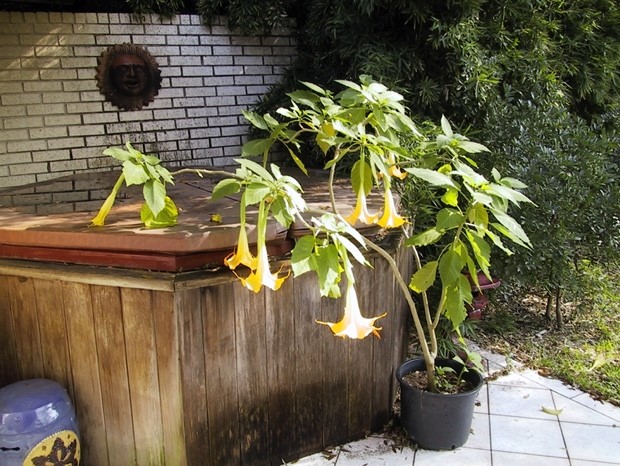Patricia L. Brown, Bexar County Master Gardener
Brugmansia and Datura are frequently confused at first. This is probably because both have large, trumpet-shaped blooms. While both are members of the Solanaceae family, which include tomatoes, potatoes, peppers and tobacco, each is in a different genus and has many different types. So that is where the similarity ends.
The first time I viewed Brugmansia was at the New Orleans Botanical Garden, during an afternoon break at a conference in August 2001.

have trumpet-shaped blooms that face upward. (Photo: Dinesh Valke, CC BY-SA 2.0)
Upon my return to San Antonio, I purchased my first Brugmansia at the now closed Wolfe’s Nursery on Broadway. My pick was Brugmansia aurea, with creamy pendulous blossoms.
Brugmansia is pollinated by long-billed hummingbirds and other pollinators.
Bexar County Master Gardeners (BCMG) started a Plant Clinic in 2003, at a little kiosk at the San Antonio Botanical Garden. A year later, we moved to the WaterSaver Lane sponsored by San Antonio Water System (SAWS). We were located in front of the Hill Country Cottage.
A Brugmansia was growing near the corner of our Hill Country cottage. A white Datura was growing on the ground between the Hill Country cottage and the Cottage Garden.

have trumpet-shaped blooms that hang down. (Photo: Patricia L. Brown, BCMG)
We met people from all over the world visiting the BCMG Plant Clinic. Visitors were fascinated by both the Brugmansia and Datura. I explained the difference, describing the background controversy. An easy way to tell the difference is that Brugmansia flowers are pendulous while Datura flowers point upward.
Brugmansia are native to the subtropical regions of South America while Datura is from the dry temperate areas of Mexico and the Southwest United States.
Brugmansia is considered extinct in the wild. It is suspected their extinction in the wild is due to the extinction of some animal which dispersed the seeds. Human cultivation ensures the genus’s continued survival.
A word of caution: All parts of Brugmansia and Datura; roots, leaves, flowers and seeds, are considered toxic if ingested, as they contain significant amounts tropane alkaloids. This can cause a rapid heart rate, hallucinations, blurred vision, and in severe cases, respiratory failure. However, large quantities may need to be ingested for severe symptoms to occur.
Cultivation:
Both Brugmansia and Datura:
- Prefer full sun or morning sun with late afternoon dappled shade.
- Need well-drained soil
- Fertilize with a 19-5-9 analysis every four to six weeks for maximum bloom production.
- Can be grown in the ground, as well as in containers in Bexar County.
- Both are root hardy and will come back each spring.
- While both are fairly drought-tolerant once established, you should provide ample water during the growing season to promote good blooms.
Height:
- Brugmansia: Woody trees, which grow to 8-10 feet if left unpruned, and anywhere from 4-12 feet wide in Bexar County. They can be pruned to promote a more compact plant, promoting more blooms. Grow as a small tree or medium shrub.
- Datura: Herbaceous shrubs which have the potential to reach 4 feet tall but usually seen about 2 feet tall with a wider spread. Daturas are great as a ground cover or used in a perennial bed.

Blooms:
- Both open their highly fragrant blooms in the evening and close in the morning.
- Brugmansia: Shades of white, pink, cream, orange and red.
- Datura: Pure white to pinkish purple
Plant near a patio in pots or in garden beds to breathe in the wonderful evening fragrance and relax after dinner.
For more information:
Angel’s Trumpet by David Rodriguez, Texas A&M AgriLife Extension Horticulturist – Bexar County.
